1980 German Grand Prix race report
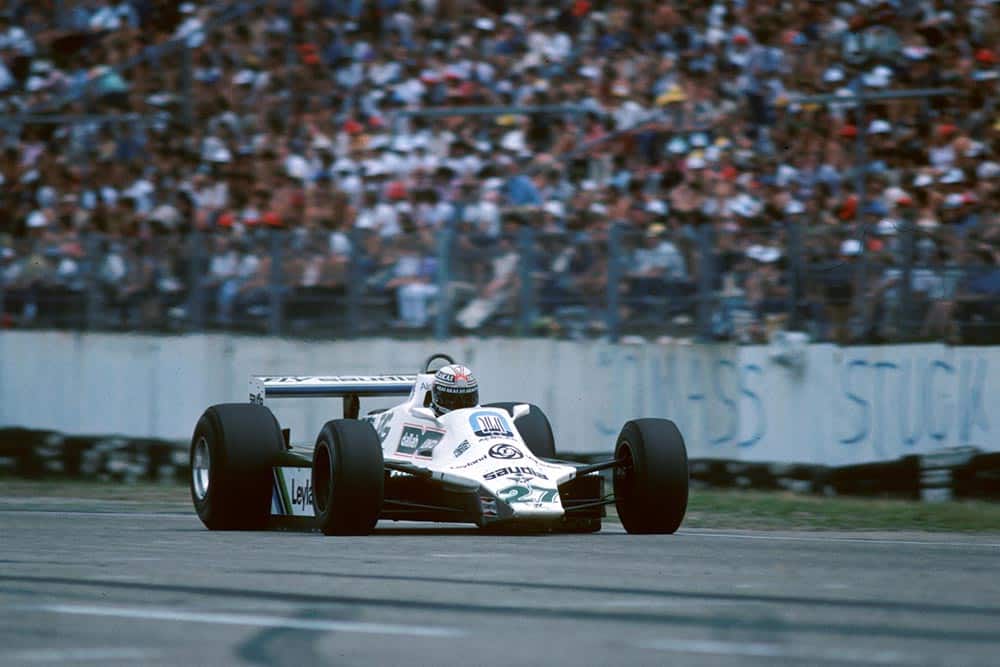
Alan Jones lead for Williams but eventually finished 3rd
Motorsport Images
The unlucky get the luck
Hockenheimring, August 10th
With a four-week break since the British Grand Prix the 1980 season seemed to be starting all over again and this feeling was magnified upon entering the vast concrete stadium of the Hockenheimring early on Friday morning to find everything comparatively still and quiet and the vast tiers of grandstand seats empty and deserted. The whole scene was one of greyness, not unproved by the knowledge that Patrick Depailler had been killed while testing on the circuit the week before. The one-man Alfa Romeo team had an unhappy grey atmosphere over them. If there was not an uneasy atmosphere of guilt hanging over some parts of the Arrows team, there should have been, in view of recent disclosures by the police regarding drugs and arms smuggling. The Williams team were counting themselves lucky they had not lost their number one driver in an almighty testing accident at Donington Park, the only damage being a sore wrist for their rugged Australian driver, Alan Jones, and a written-off test car. The Ferrari team were looking for a new driver for 1981 since Scheckter announced he was giving up racing at the end of the season, and they were hoping he would give them good service for the remainder of his contract. Renault had got to the bottom of their piston failures, and were hoping for good results on the fast “ring”, and Ligier had convinced everyone that their tyre troubles at Brands Hatch had been caused by new wheels and that the problem had been solved. This “unreal” atmosphere was broken by the bark of the first Cosworth V8 being started up, followed by the flat-sounding turbocharged Renaults, the harsh bark of the Alfa Romeo V12 and the sound of the Ferraris. Instantly all was well with the world and the morning test-session was about to get under way.
There were one or two changes in the familiar scene, Hector Rebaque was still replacing Ricardo Zunino on Bernie Ecclestone’s “paying” roll, and had been given the B-spec car with the Weismann gearbox. Alain Prost had a new McLaren M29C, Harald Ertl was driving the second ATS, the Lotus mechanics were making an 81B out in the paddock, Renault had made a new car for Arnoux, Fittipaldi had the second ot their new cars for Rosberg, the Williams team had a new car for Alan Jones, his regular one being moved away to replace the wrecked test-car, and Rupert Keegan had joined the list of hopefuls with an ex-works Williams.
On the Goodyear tyre front everyone was on 15″ diameter front tyres and some new narrower rear tyres were being used in view of the high-speed characteristics of the Hockenheimring, these new tyres presenting a lot less frontal area without loss of cornering power. Michelin were doing their best with Renault and Ferrari and hoping they had made up sorne of the leeway lost recently, making it pretty clear that they had enough problems to solve without worrying about FOCA/FISA suggestions as to what they should do about tyres for the future.
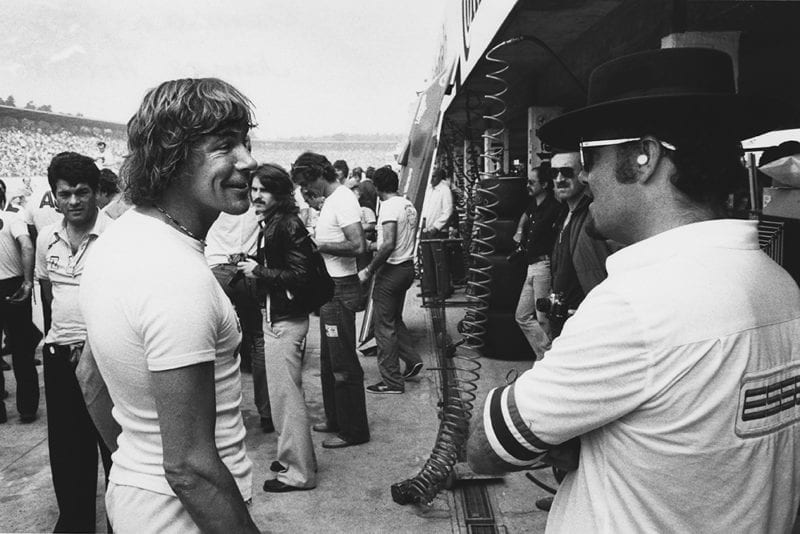
Former world champion James Hunt returned to the paddock
© Motorsport Images
Qualifying
The weather was very grey and cloudy and there were a few ominous rain spots as the first cars set off. It was not long before Watson. was seen walking in from one end of the pits and Rosberg from the other. Watson’s trouble was terminal, his Cosworth V8 had blown-up in a big way. Rosberg was soon back in the car again, with the help of his mechanics to restart his engine.
While Piquet’s mechanics changed the brake master cylinders on his Brabham he went out in the spare car, but Ertl had to wait while the ATS mechanics sorted out injection problems. Andretti soon swapped from his “new spec.” Lotus 81/2 to his old spec. Lotus 81/1 and before the session ended the rain began. Jarier went off in a big way and crumpled the monocoque of his Tyrrell 010/4 and the Tyrrell mechanics started making a pew car out in the paddock.
Before the one hour session of timed practice began at 1 pm the rain was beginning to fall and the great concrete stadium presented a foreboding atmosphere. Many of the teams sent their drivers out on “slick” tyres in the hope that the rain would stop, but instead it got worse and within 20 minutes it was bucketing down. As everyone had made re-adjustments for the narrower rear Goodyear dry-tyres, some of them were in trouble fitting wet weather tyres as they only came in wide-tread form. A team like Williams who had been forewarned of having to accommodate “narrow” dry-tyres and “wide” wet-tyres had made provision with suitable wheels with different hub-offset. For a time while it was just pouring down a lot of drivers went on splashing round, and it was noticeable that the two Ferraris were suddenly well up the list, but when it really began to p— down the whole practice session stopped for want of visibility more than anything else. By 1.30 pm it began to ease off and eventually the rain stopped, but it was still very wet. The best lap times possible were about 15 sec slower than in the dry, and it was a contest to see if anyone could break two minutes. Arnoux came very close, with 2 min 00.15 sec and Piquet wasn’t far off with 2 min 01.71 sec, but for the rest anything under 2 min 05 sec was exciting. At one point a burly Brabham mechanic strode through the water carrying what looked like an enormous rag-doll! It was Nelson Piquet being delivered to the dry ground to keep his racing boots dry. Following the morning troubles Jarier had taken over the spare Tyrrell and Watson had taken over the spare McLaren. Although practice was not significant should it subsequently prove to be dry, there was always the uneasy feeling that the wet weather could go on.
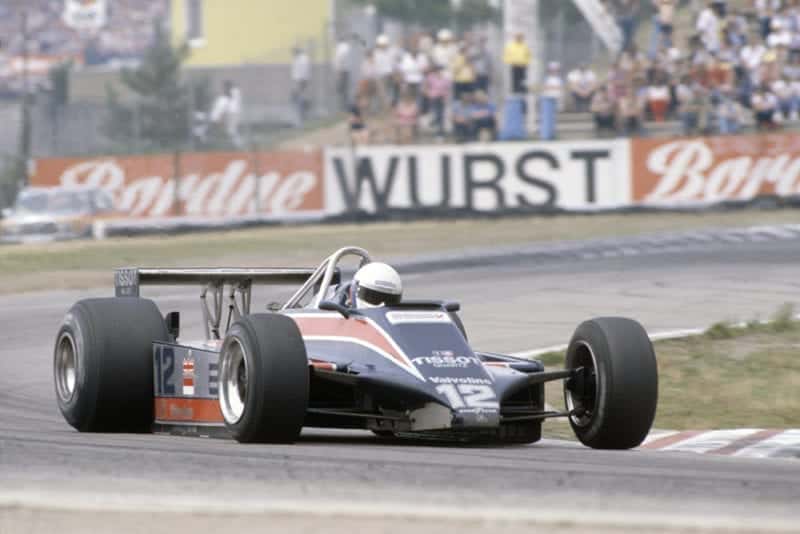
It was 11th on the grid for Lotus’ Elio de Angelis
© Motorsport Images
On Saturday morning the skies were still grey and a short sharp shower of rain fell just before the 10 am test-session began, but the track soon dried and then everything was under way properly. The ambiance in the great concrete stadium changed completely, for many of the stands filled up with spectators and a pretty sizeable crowd turned up to watch. The existing lap record of 1 min 51.89 sec set up in last year’s race by Villeneuve (Ferrari T4) was almost instantly beaten and it was soon obvious that if you could not beat it you would not even qualify for this year’s race. The front runners had last year’s pole-position time to aim at which was 1 min 48.48 sec set up by Jabouille with the Renault. Everyone was getting into the swing of things, some more than others, and Rosberg spun off and damaged the skirts on his new Fittipaldi, while Watson ground to a halt with electrical trouble and had to take over the spare McLaren again. Villeneuve was in the spare Ferrari as his own car sprang a fuel leak in its rubber-bag fuel tank and Pironi took over the spare Ligier when his own car had engine trouble. Piquet’s car had the clutch go wrong and he transferred to the spare car. but Rebaque seemed to be getting on all right with the Weismann gearbox. The usual fast drivers like Pironi, Piquet, Laffite, Arnoux and Jones were all down into the 1 min 47 sec bracket, but Reutemann was far from happy with the handling of his Williams. As it was all unofficial and the times being recorded did not count for the starting grid everyone was fairly relaxed and unworried, providing they were in this 1 min 47 sec group, but shortly before the test-session ended there was a flurry in the hen-coop! Pironi (Ligier) was fastest with 1 min 47.01 sec, when Alan Jones came in and stepped straight out of Williams FW07B/9 into the waiting spare car FW07B/5 which was set up with the best of everything, including removal of all the drag-producing brake air-ducts. Jones went straight out and did three flying laps in the 1 min 46 sec bracket, ending up with 1 min 46.02 sec. Although it did not count for the starting grid it was real enough and the Williams team had shown their hand. It made the Renault, Ligier and Brabham timekeepers sit up and take notice. Right at the end of the test-session de Angelis had a rear wheel centre break and suffered an almighty series of spins in consequence, but escaped unscathed.
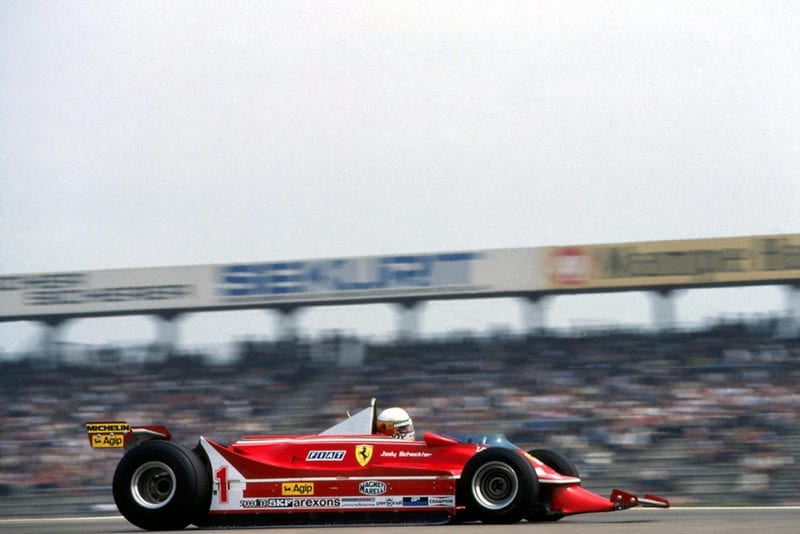
Jody Scheckter’s 1980 woes continued with a 21st in qualifying
© Motorsport Images
By 1 pm when the official timed session began, with everything hanging on it to decide grid positions due to yesterday’s rain, the weather was warm and sultry and gave the impression that if the cloud bank was to break there would be a heat-wave, and if it didn’t there could be a thunderstorm. As it turned out everything held fast. Piquet was in the spare Brabham, Villeneuve was back in his own Ferrari, the Lotus of de Angelis had been repaired, Arnoux was in the new Renault but Jones was still in the very fast spare Williams, much to everyone else’s consternation. During the morning the Renaults had been testing with full fuel tanks, but now they were set up for a five-lap dash and after only seven minutes Jabouille had shattered Jones’ morning time with a lap in 1 min 45.99 sec, but the Williams driver responded almost immediately with a 1 min 45.90 sec. After a short pause Jabouille went out again and did 1 min 45.89 sec and the heat was really on. Arnoux could not match these times, nor could the Ligier drivers, while Reutemann was being left behind, but Piquet was up with the Ligiers. Clearly Reutemann’s car just would not go any faster so he was called in and given Alan Jones’ race-car, the new one, and the Argentinian promptly got in among the Ligiers and the Brabham.
With 20 minutes left Jones was out again and retook pole position with 1 min 45.85 sec, to which Jabouille and the Renault had no answer. Arnoux stuck at exactly 1 min. 46.00 sec, which gave him third overall and Reutemann ran him close with 1 min 46.14 sec and the rest were in a different sphere. Rosberg had done a courageous job and was eighth fastest overall, but even so was nearly two seconds slower than Jones, and Andretti in ninth place, with the Lotus 81, looked encouraging for Team Lotus until you realised he was nearly three seconds slower that Jones. It was now all over, but pole-position man had come to a stop out on the circuit in a shower of engine oil from a vast leak in the left-hand side-pod where the oil radiator is located, but it was not too serious. Thus the grid was settled within the space of one hour and reactions were very varied; the Williams team were quietly confident, the Renault team were satisfied but apprehensive, for Arnoux’s engine had broken a valve spring and it wasn’t the first one during the two days, while the Ligier team were a bit nonplussed at not being up the front. Brabhams were very happy with their Brazilian ace and satisfied that the Weismann gearbox in the second car was still performing satisfactorily, Fittipaldi was delighted to see one of his cars so far up the grid and his own was well up too. Villeneuve had done the best he could, as always, but Scheckter was hoping not too many people would notice that Giacomelli with the Alfa Romeo was ahead of him. Ensign and Unipart breathed a sigh of relief that Lammers had scraped their car into last place and Tyrrell’s hopes for better things were not fulfilled, with his two drivers at the back of the grid. Keegan had failed miserably and Ertl openly admitted that Formula One speeds were now way beyond his capabilities and he had been foolish to imagine he could qualify for the grid.
Race
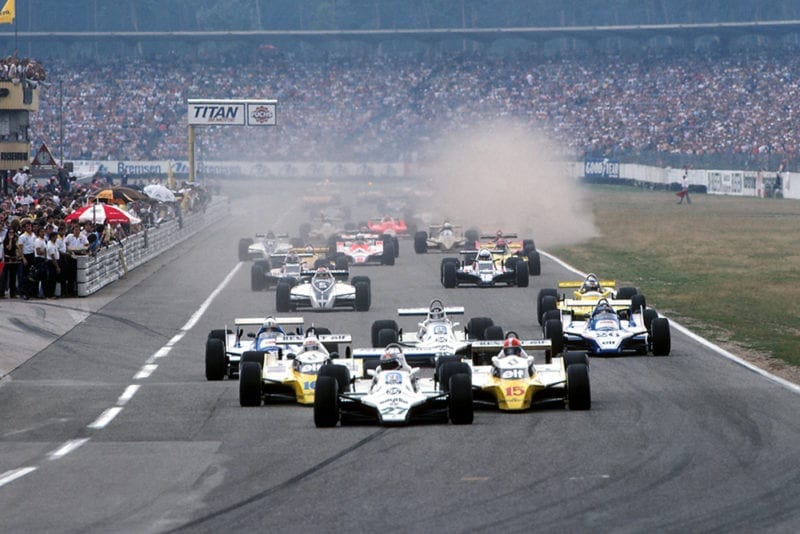
Alan Jones leads into the first corner
Motorsport Images
By Sunday any signs of rain had disappeared, which was just as well as four of the teams were properly equipped to make a sudden change from 16″ wide “dry” tyres to 21″ wide “wet” tyres, though Patrick Head of the Williams team smiled and said they would be all right. Some teams were visualising having to hack the bodywork about with tin-snips during the tyre change, if it suddenly rained! At 11 am it was getting very hot and stuffy and there seemed to be no air in the stadium, for any that had been there was quickly absorbed by the 85,000 spectators in the concrete grandstands. In the 30 minute warm-up Daly was trying the new Tyrrell that had been built in the paddock, Piquet was settling to race the spare Brabham, Reutemann was in the spare Williams, as Jones was back in his own car, Surer had Ertl’s ATS as a stand-by, Andretti was in the oldest Lotus 81, Pironi was back in his own Ligier and Laffite was using the spare Ligier. It was only a 30 minute warm-up but a lot happened. Jarier’s engine blew up and the hard-worked Tyrrell mechanics got stuck in to do a lightning engine change on 010/1. Reutemann had a small fire break out on the spare Williams, the Osella broke its rear suspension and Arnoux’s Renault was in trouble with a side-skirt and the gearbox was taken apart as well. With the start due at 2 pm there was some feverish work going on during what would normally be a lunch break.
The Osella was repaired, the Renault put right and the rear engine put into the Tyrrell all right, but in the Williams camp the drama continued. The fire had been caused by a leaking petrol union and luckily Reutemann stopped smartly out on the circuit, undid the engine cover with his penknife and directed the fire-fighters who were using inert gas extinguishers and not foam, so very little damage was done. The repair was effected but it took a long time as it was very inaccessible. Meanwhile Reutemann’s own car, number 5, was race-prepared but the Argentinian hoped the spare car, number 8, would be ready as he was so much happier with its handling. The minutes were ticking by and when the job was finished the air-line to the starter was plugged in and then the starter pinion refused to engage. More frantic work with screwdrivers, WD40, long steel bars and finally the engine fired and Reutemann prepared to get in, but then a plug cut-out. This was changed and once more the starter pinion refused to engage. It was now time for the cars to leave the pit lane on their way round to the starting grid. A final decision had to be made; one more try, if it fired Reutemann would take it, if it didn’t he’d take number 5. The air bottle hissed, the pinion didn’t go in so that was it, everyone dropped their tools and rushed over to the pit lane and Reutemann was strapped into number 5 car.
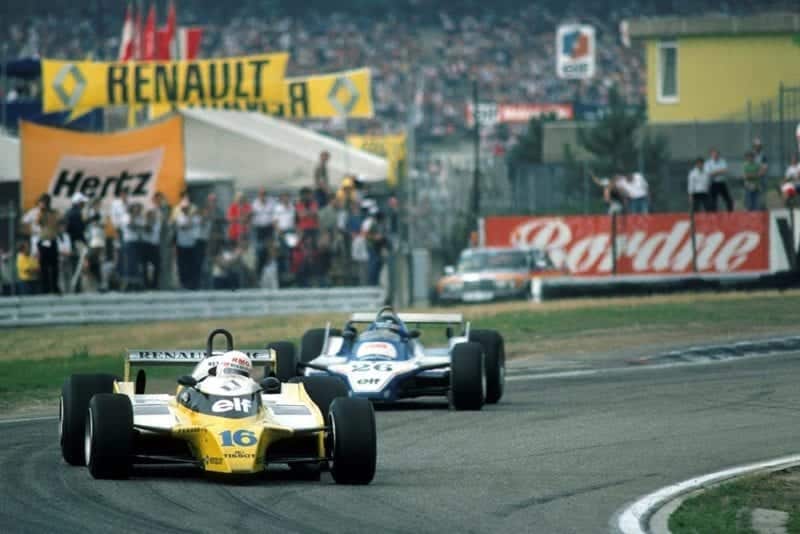
Rene Arnoux in a Renault RE20, leads eventual winner Jacques Laffite in his Ligier JS11/15.
© Motorsport Images
This was not the only drama. In the ATS pit Surer was preparing to go off in the ATS D4/03 when one of the mechanics felt the rock in the rear wheel bearings, as a matter of course, and one was too floppy. It was too late to do anything about it so Surer was bundled into D4/02, which he had not driven and had little idea of what its characteristics were like, but it was Hobson’s Choice. By diving into the pit lane at the end of the lap instead of pulling up on the grid Watson and Reutemann sneaked in an extra warm-up lap, and then all 24 starters were lined up correctly on the assembly grid, with the Williams of Alan Jones on pole-position on the right. He led them away on the parade lap and everyone was nicely positioned back on the grid. The red light came on, then the green and a fantastic roar heralded the start of the 45-lap race. Piquet was in trouble almost at once with a clutch that would not grip and both Arrows cars had the same trouble as they changed into second. At the back of the grid Daly was also in the same trouble, made all the more embarrassing by his engine stalling. The Brabham and the two Arrows crept away with their drivers nursing the power and praying, and Daly free-wheeled as far as he dare before he let the clutch in and caught the engine.
It was Jabouille who led the opening lap, with Alan Jones right on the Renault’s tail, Arnoux, Pironi, Laffite, Rosberg and Reutemann in hot pursuit. Poor Marc Surer was finding the spare ATS handled nothing like his own car, and Piguet, Mass, Daly and Patrese brought up the rear. All four now had their clutches gripping firmly and were changing gear without using the clutch, so were out to make up for lost time. Piguet fairly stormed away and from 21st on the opening lap he flashed up to 11th by lap six, aided by Rosberg and Rebaque going into the pits. The Fittipaldi driver had led Reutemann briefly, but then came round with his rear aerofoil broken off and spent a long time in the pits having another one fitted. Rebaque saw a spume of oil in his mirrors and stopped promptly at the pits, which was just as well for a bearing seal on top of the vertical selector shaft in the Weismann gearbox had failed and the gearbox oil pressure was open to the winds. There was nothing that could be done so it was the end of the Mexican’s race.
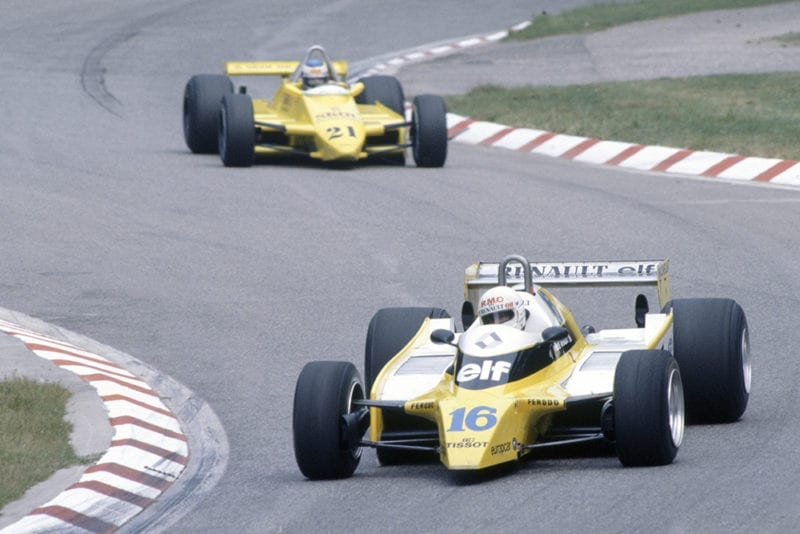
Arnoux leads Fittipaldi driver Keke Rosberg
Motorsport Images
Jones was hounding Jabouille but the Renault team leader looked safe and sure in the lead and providing everything held together it didn’t seem as if the Australian was going to improve his situation, but with Alan Jones you never know. He doesn’t just sit behind another car in a resigned fashion, his crafty brain was working away at the situation. They had pulled a slight lead out on Arnoux, who in turn was comfortably ahead of the Ligiers, if a few feet can be considered comfortable! Laffite had passed his team-mate and Reutemann was shadowing them, but not pressing them. These six were away on their own and the rest were being led by the incredible Villeneuve in seventh place from a 16th place starting position. Behind him came de Angelis, Andretti, Fittipaldi and Piguet, who was still making up places, followed by Cheever, Watson, Giacomelli, Surer, Prost, Lammers and Jarier, with Mass closing up on them. Bringing up the rear were Daly and Patrese. In the pit lane the Fittipaldi mechanics were still working on Rosberg’s car when to their dismay they saw.their team leader coming in with brake problems. Eventually both cars rejoined the race. On lap eight de Angelis got by Villeneuve, but Piguet was catching both of them and the hard-driving Brazilian was soon past the Ferrari, and then past the Lotus, which put him into seventh place, but while he had gobbled up the tail-enders and battled his way past the mid-field runners he was not gaining on the leading six cars so seventh place was all he was going to achieve, but it was an heroic effort nonetheless.
At the front of the race nothing had changed, Jones was not giving up and Jabouille was not weakening, but Laffite had broken clear of Pironi and Reutemann and was pressing Arnoux hard, but with no hope of getting by. The scene was very tidy with Renault v Williams, then Renault v Ligier and then Ligier v Williams and it was difficult to see how the situation was going to resolve itself. There was some hard driving going on at the front and new lap records were being set regularly, first Reutemann, then Jabouille, then Jones, then Laffite, then Jabouille again. The pits were still busy for Villeneuve was in and out like a flash for another set of tyres and Fittipaldi was back in again, then Scheckter was in for tyres and Pironi appeared going slowly at the end of lap 18. A drive-shaft had failed coming down the back straight and as Jabouille and the others went on the Ligier limped through the escape road at the entrance to the stadium and made its way to the pits to retire. This was the first chink in the armour. Reutemann did not profit from the space in front of him so we still had Jabouille and Jones, then Arnoux and Laffite and then a gap before Reutemann appeared and a long gap before Piguet appeared, with de Angelis in seventh position. Andretti was leading Watson, Giacomelli and Cheever, while Mass had worked his way up behind the Osella. Since his stop for new tyres Villeneuve had caught and passed Jarier and Surer, but Scheckter was way back, and was lapped by the leaders.
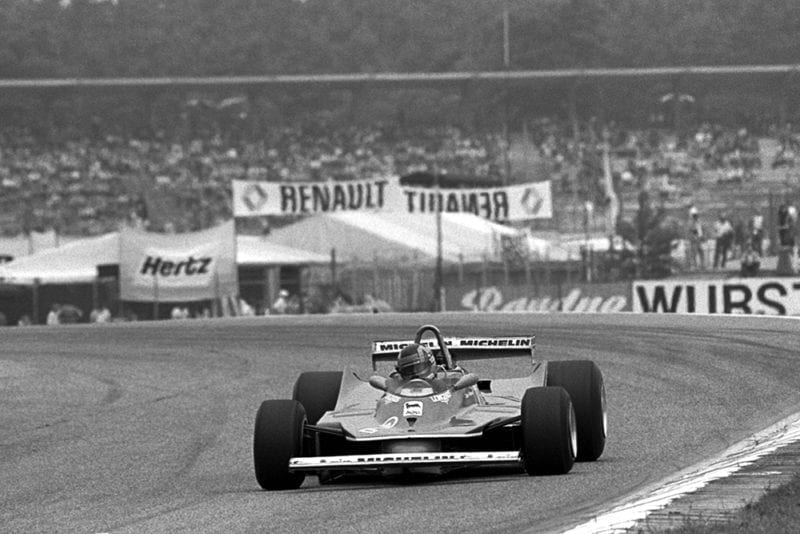
Gilles Villeneuve secured the final championship point with 6th
© Motorsport Images
As Jabouille entered the stadium to end lap 27 the Williams was even closer, if that was possible, and as they started the twists and turns the Renault suddenly slowed and Jabouille waved Jones by. Valve spring trouble had hit the V6 engine again and poor Jabouille limped into the pits to retire. As if that wasn’t bad enough for the Renault team, Arnoux failed to appear at the same time, his engine suffering the same fate at almost precisely the same time out on the circuit. This left Jones with a very comfortable lead over Laffite, who in turn was well ahead of Reutemann, while Piguet was now a secure fourth, which was well deserved after his determined driving in the opening stages. Villeneuve had already caught and passed Prost, and now passed Mass and was after Giacomelli, but the little Alfa Romeo driver had other ideas for Andretti was slowing ever so slightly and Watson passed him, so Giacomelli could see hopes of moving up a place, and every one counts. Scheckter had had a moment of glory when he caught and passed Jan Lammers in the Ensign, so that he was no longer last. Giacomelli passed the ailing Andretti, who had been over the kerbs and severely damaged the left-hand skirt on the Lotus, and the Alfa Romeo was now in a spray of oil that was coming from the back of Watson’s McLaren. On lap 34 Giacomelli got by the McLaren and into sixth place, while Watson began to slow until the McLaren engine gave up on lap 40.
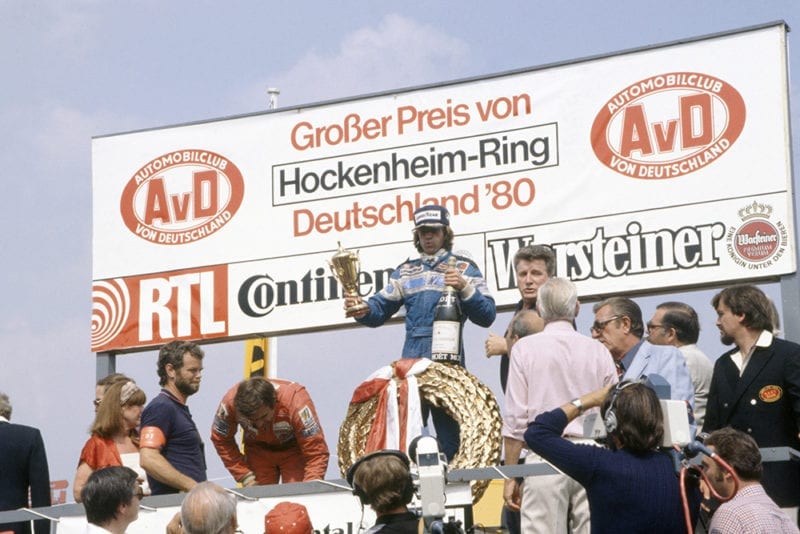
It was third career win for Frenchman Laffite
© Motorsport Images
But that was not important. What was important was that Alan Jones could feel his left front tyre going soft and as he rounded the stadium to complete lap 40 he slowed dramatically and headed for the pits. Without hesitation his mechanics changed both front tyres and he was off again before the flagman at the pit exit could give him the all-clear. Jonesey-boy was in a hurry. Laffite and Reutemann had gone by so he was now third, with only five laps left to run. There was nothing he could do, but he didn’t give up and set a new lap record on lap 43, at 1 min 48.49 sec (225.245 kph – about 140 mph). On this same lap de Angelis lost a well-earned fifth place when a bearing broke up in the right rear hub and he could do nothing but limp into the pits to lose two laps and be classified last. A very happy, but lucky, Jacques Laffite took the chequered flag though no-one begrudged him his win as he had been the unlucky one with tyre trouble at Brands Hatch and now it was Alan Jones’ turn. Any ideas that Reutemann was making a last minute bid to save the day for Frank Williams during the closing laps were a bit misguided for it was all much too late, though the Argentinian did make his fastest lap on the penultimate lap, but so did Laffite and Piguet for that matter. In fact the first six finishers, Laffite, Reutemann, Jones, Piguet, Giacomelli and Villeneuve were all flat-out to the finish. It was not a Grosser Preis von Deutschland, but it wasn’t a bad Kleiner Preis. – DSJ.
